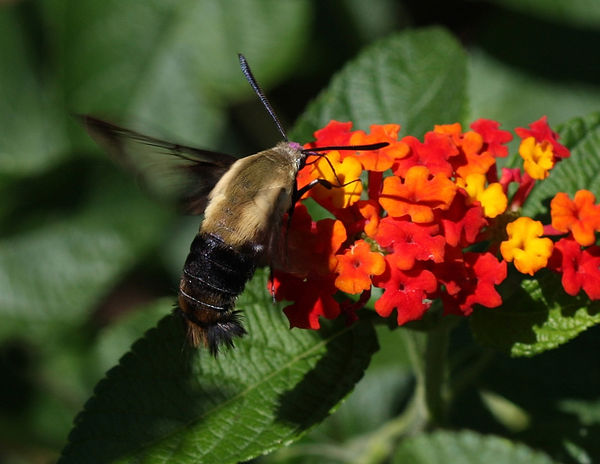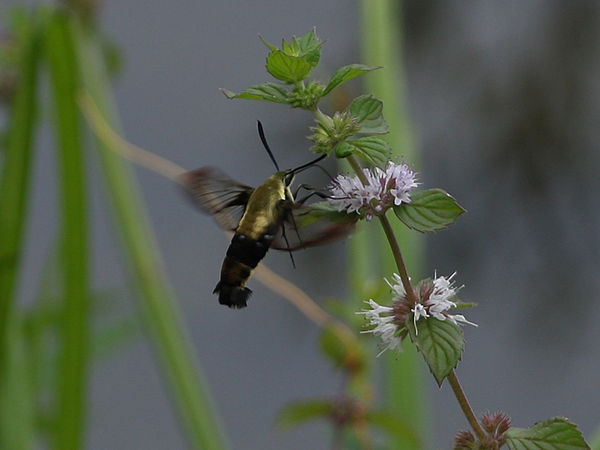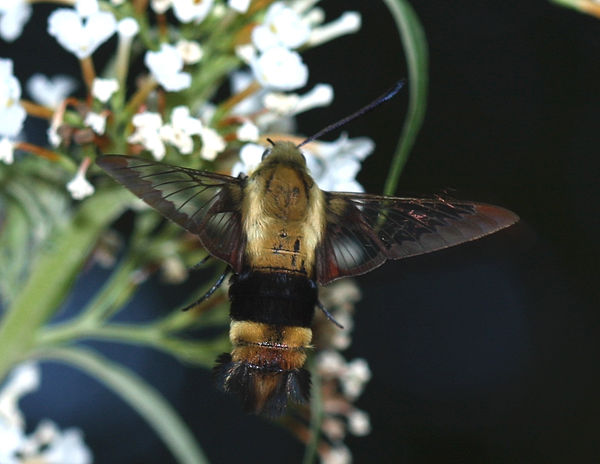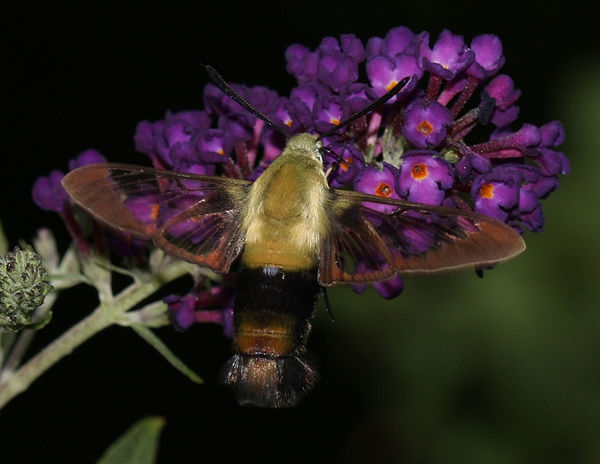Check out Software and Computer Support for Photographers section of our forum.
Tips on shooting Hummingbird Moths
Aug 18, 2012 11:29:22 #
There seems to be a lot of interest in hummingbird moths (and hummingbirds)! They seem to always generate comments from some who hadn't seen them in years but still recall them with fond memories and from others who had often seen them but did not know what they were.
Since they have no seeming fear of humans, they make it easy to get very close to them and they often will get very close to you.
They are capable of rather fast flight but we usually see them in a feeding mode where they are hovering and moving quite slowly from bloom to bloom. The difficulty in shooting them rests with their supersonic wing speeds and getting them in focus.
As to focus, I find autofocus is the only way to go. It is at least as accurate as manual focus and in as busy a scene as this, it is much faster.
Handshake is a problem that is mitigated with a tripod or monopod and either will make a huge difference in the sharpness of your photos.
There are two choices to make...flash or no flash. Without flash, your photos will require ultra-fast shutter speeds if your intent is to stop the wing motion completely. This means that you will be limited to the brightest portions of the day in bright sunshine for proper exposure and/or the use of higher ISO settings. With flash, you will need to be careful of the color of the blooms that the moth is feeding on...white blooms tend to be way over exposed by the flash even though the moth might be perfectly exposed. I am personally torn between the two...I am not a big fan of flash photography but there are times when nothing else will do. On the other hand, a flash can completely stop the wing motion. I end up by shooting both ways.
The below examples show results along with the settings used to capture the shots. You need to determine what effect you desire...sharp body with blurred wings to indicate motion; absolutely stopped action on all portions...and then select the settings. Suggested settings will only put you in the ballpark...you will have to view the results on your monitor and adjust from there. It is usually easier to shoot in shutter priority mode when subject motion is the problem. I find that shutter mode and a shutter speed setting of 1/640 usually gives a nice blur to the wings with sharp body features. Higher shutter speeds will reduce wing motion but will also reduce the depth-of-field.
Point and shoot cameras are a little more difficult to track with than SLR's but when the subject is captured they make an excellent picture. Those that also have a viewfinder tend to be more suited to shooting moving subjects, I find. Many times, they have a maximum shutter speed of 1/1,000...this is not fast enough to stop this wing motion, so opting for flash makes more sense. These will work with just a little more effort!
I hope this gets you started and I wish you the best. Keep on shooting. Chances are that some day your photography will bring you as much joy as ERV gets from his and I do from mine.
Thanks,
Bob
Since they have no seeming fear of humans, they make it easy to get very close to them and they often will get very close to you.
They are capable of rather fast flight but we usually see them in a feeding mode where they are hovering and moving quite slowly from bloom to bloom. The difficulty in shooting them rests with their supersonic wing speeds and getting them in focus.
As to focus, I find autofocus is the only way to go. It is at least as accurate as manual focus and in as busy a scene as this, it is much faster.
Handshake is a problem that is mitigated with a tripod or monopod and either will make a huge difference in the sharpness of your photos.
There are two choices to make...flash or no flash. Without flash, your photos will require ultra-fast shutter speeds if your intent is to stop the wing motion completely. This means that you will be limited to the brightest portions of the day in bright sunshine for proper exposure and/or the use of higher ISO settings. With flash, you will need to be careful of the color of the blooms that the moth is feeding on...white blooms tend to be way over exposed by the flash even though the moth might be perfectly exposed. I am personally torn between the two...I am not a big fan of flash photography but there are times when nothing else will do. On the other hand, a flash can completely stop the wing motion. I end up by shooting both ways.
The below examples show results along with the settings used to capture the shots. You need to determine what effect you desire...sharp body with blurred wings to indicate motion; absolutely stopped action on all portions...and then select the settings. Suggested settings will only put you in the ballpark...you will have to view the results on your monitor and adjust from there. It is usually easier to shoot in shutter priority mode when subject motion is the problem. I find that shutter mode and a shutter speed setting of 1/640 usually gives a nice blur to the wings with sharp body features. Higher shutter speeds will reduce wing motion but will also reduce the depth-of-field.
Point and shoot cameras are a little more difficult to track with than SLR's but when the subject is captured they make an excellent picture. Those that also have a viewfinder tend to be more suited to shooting moving subjects, I find. Many times, they have a maximum shutter speed of 1/1,000...this is not fast enough to stop this wing motion, so opting for flash makes more sense. These will work with just a little more effort!
I hope this gets you started and I wish you the best. Keep on shooting. Chances are that some day your photography will bring you as much joy as ERV gets from his and I do from mine.
Thanks,
Bob
Shutter Priority, 1/320, f/7.1, NO FLASH

Shutter Priority, 1/640, f/4-shot at about 30', deep crop, NO FLASH

Manual Mode, 1/200, f/5,WITH FLASH

Manual Mode, 1/200, f/8, WITH FLASH

Aug 18, 2012 11:36:18 #
Aug 18, 2012 11:46:31 #
vernsgirl
Loc: Kingston, OK
Thanks for the information. and the great photos. I have taken photos of the hummingbird moth (and Hummingbirds.)
First one I saw was at local nursery, not knowing what it was.
Never consider using flash,
99% of the photos I take are birds and small critters.
Thanks again for the information.
First one I saw was at local nursery, not knowing what it was.
Never consider using flash,
99% of the photos I take are birds and small critters.
Thanks again for the information.
Check out Smartphone Photography section of our forum.
Aug 18, 2012 11:47:29 #
Aug 18, 2012 18:06:59 #
Aug 18, 2012 18:10:09 #
Aug 18, 2012 19:22:58 #
Check out Black and White Photography section of our forum.
Aug 18, 2012 19:31:19 #
Aug 19, 2012 06:46:08 #
I have never seen humming bird moths before, so I checked Wikipedia to find where they are. It shows them in Asia , Europe and north Africa but not the Americas. Are you finding them in the US and where?
Aug 19, 2012 06:47:59 #
I do believe the correct name for the hummingbird moth is called a sphinx
bob_71 wrote:
There seems to be a lot of interest in hummingbird... (show quote)
Aug 19, 2012 08:41:26 #
I have never seen a hummingbird moth before and really enjoyed the photos--thank you found this really interesting
Aug 19, 2012 09:45:04 #
camerabuff58, you are correct inn that Hummingbird Moths are of the Sphingidae family, and of the sub-family Macroglossinae. The four most common varieties that are observed in North America are the one shown in my photographs Snowberry Clearwing Moth (Hemaris diffinis), the Common Clearwing Moth (Hemaris thysbe), the Tersa Sphinx moth (Xylophanes tersa), and the White-Lined Sphinx Moth (Hyles lineata).
All are commonly referred to as hummingbird moths.
Thanks for your post.
Bob
All are commonly referred to as hummingbird moths.
Thanks for your post.
Bob
Aug 19, 2012 09:51:42 #
Bamboo, The specific moth in my photographs is found throughout the US east of the Continental Divide, from Maine to Florida. I spent the first 25 years of my life in NC and there were lots of them there. These creatures are not much larger than an over-sized bumble bee and have a similar feeding habit. They are often mistaken for one. Once you have seen one and recognize it, you will never forget them.
Thanks for posting!
Bob
Thanks for posting!
Bob
Aug 19, 2012 09:53:29 #
To all the others who have posted...thank you greatly for your comments!
Bob
Bob
Aug 19, 2012 10:51:58 #
Great photos and good info. I've photographed the day flying sphinx moths (aka Hummingbird Moths)and have run into the same problems you describe.
If you want to reply, then register here. Registration is free and your account is created instantly, so you can post right away.
Check out Travel Photography - Tips and More section of our forum.









